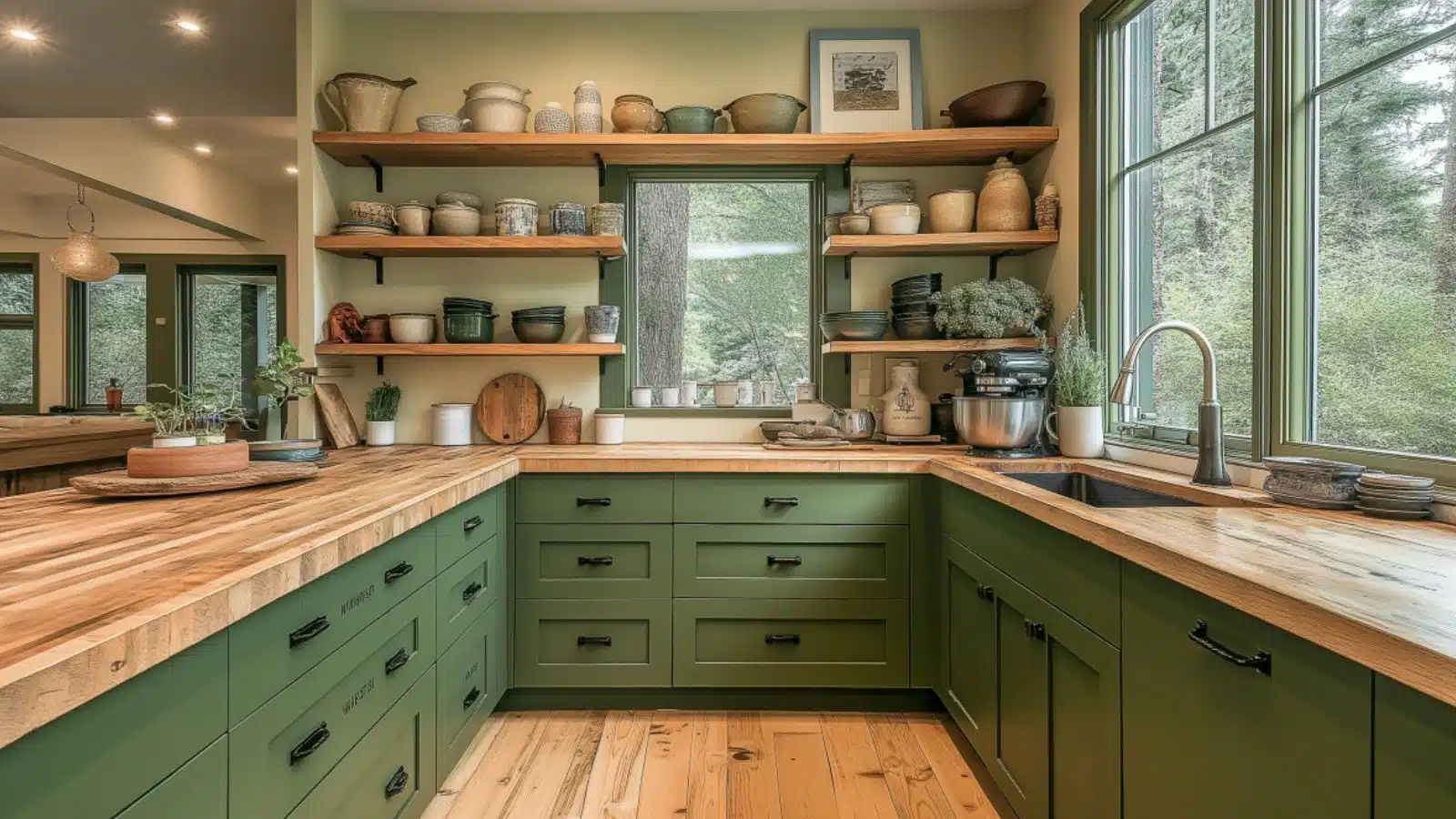Green Kitchen Designs with Wooden Accents: A Natural Blend
Table of Contents
In recent years, green kitchen designs with wooden accents have emerged as one of the most refreshing and sustainable trends in interior design. From sage cabinetry paired with walnut countertops to olive green walls softened by oak shelving, this look celebrates the calming qualities of nature while creating a space that feels warm, organic, and inviting. According to design forecasts, searches for “green kitchens” have soared, and Pinterest boards are overflowing with kitchens that marry leafy hues with earthy textures.
Why is this look so appealing? It taps into our need for balance—a space that feels grounded yet stylish. Green evokes growth, peace, and renewal, while wood introduces depth, craftsmanship, and timeless beauty. Together, they create a harmonious environment that enhances both form and function.
This guide explores how to design a kitchen that embraces green tones and wood textures. Whether you’re planning a full renovation or a subtle update, you’ll find practical tips, material pairings, layout inspiration, and decorative ideas that bring the outdoors in. Let’s explore how to blend these two natural elements to create a kitchen space that’s as beautiful as it is livable.
Choosing the Right Shade of Green for Your Kitchen
Selecting the perfect green is the cornerstone of your kitchen’s aesthetic. While green is versatile, each shade evokes a different mood and works differently with wood tones. Soft sage and dusty eucalyptus create a serene, vintage feel. Deep forest or emerald adds drama and sophistication. Olive green brings in an earthy richness, while mint and pistachio lend a playful, retro charm.
Pair your green tone with wood that complements its undertone. Cool greens go well with lighter woods like birch or ash, while warmer greens look stunning with richer finishes like walnut or teak. If you’re painting cabinets, choose matte or satin finishes for a more natural effect.
Green Tone Pairing Guide
| Green Shade | Wood Type to Pair | Visual Mood |
|---|---|---|
| Sage Green | Light oak or maple | Calm, organic, soft |
| Olive Green | Walnut or reclaimed pine | Earthy, grounded, rustic |
| Forest Green | Dark mahogany | Dramatic, moody, modern |
| Mint or Pistachio | Whitewashed pine | Fresh, airy, playful |
Integrating Wooden Accents for Warmth and Balance
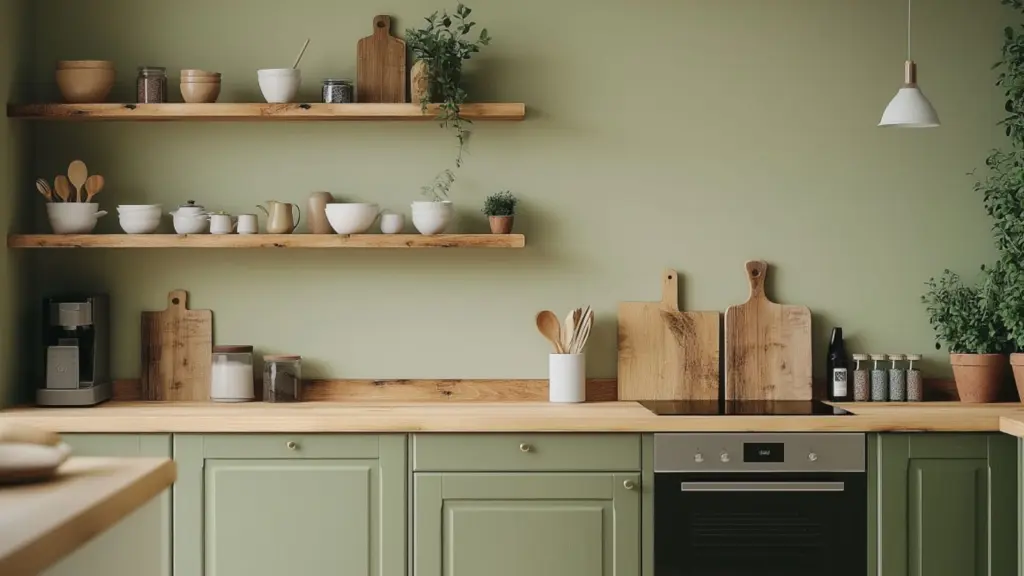
Wood serves as the soul of a green kitchen. Whether subtly integrated or prominently featured, wooden accents soften the boldness of green and infuse warmth into the space. The beauty lies in the variety of applications—from butcher block countertops and ceiling beams to open shelving and drawer pulls.
Start with the foundation: wooden floors set a warm tone that’s perfect for anchoring green cabinetry. Butcher block countertops offer a practical and stylish alternative to stone. Floating wooden shelves can be both decorative and functional, allowing space to display dishes, potted herbs, or natural ceramics.
Choose your wood tone thoughtfully. If your green is vibrant, keep the wood pale to maintain lightness. If your green is muted or dark, deeper wood tones can enhance the richness and elegance. The finish matters too—natural matte or lightly oiled wood feels more organic and refined than glossy lacquer.
Wood Accent Applications in Green Kitchens
| Accent Type | Best Pairing Green | Design Tip |
|---|---|---|
| Open shelving | Sage, olive, or emerald | Mix with ceramics or glassware |
| Butcher block counters | Mint, forest green | Oil regularly to maintain texture |
| Wood vent hoods | Any green tone | Adds rustic flair to modern setup |
| Beadboard panels | Olive or sage | Ideal for cottage-style kitchens |
Play with Contrast Through Backsplashes and Walls
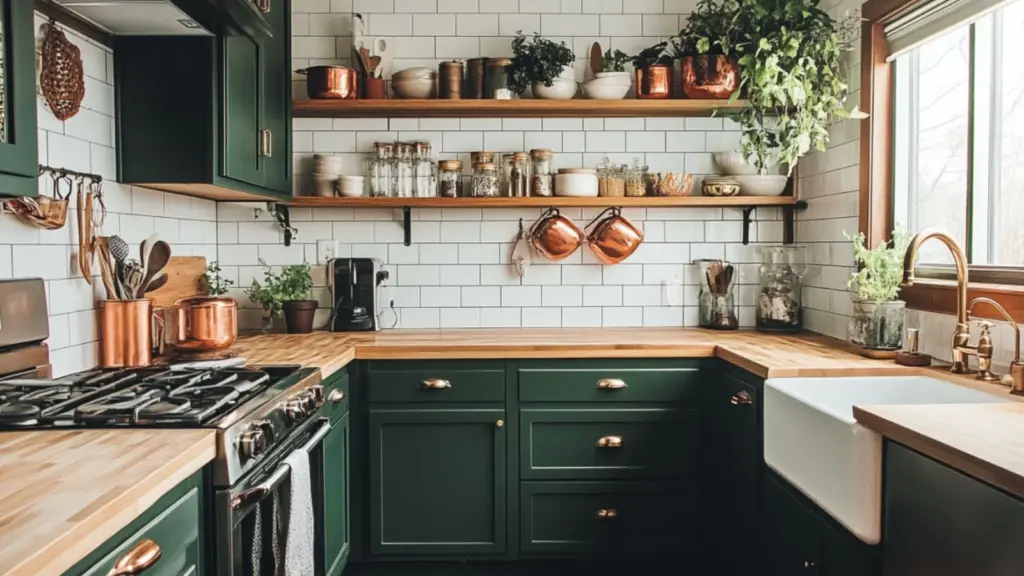
Backsplashes and wall treatments are excellent ways to enhance the visual interest of a green and wood kitchen. For balance, consider contrasting materials like white subway tiles, natural stone, or even beadboard paneling. These elements can break up the green cabinetry and wood surfaces, ensuring the space feels open rather than overly saturated.
For a bold look, use patterned tiles in soft white and green hues. For something subtle, try a whitewashed brick wall or a vertical tongue-and-groove wall in a pale cream. These touches will tie the kitchen together while allowing the green and wood elements to shine.
Backsplash and Wall Design Options
| Material | Best Green Pairing | Design Mood |
|---|---|---|
| White subway tile | Sage, olive | Classic, clean, coastal |
| Tumbled marble | Forest green | Sophisticated and earthy |
| Beadboard paneling | Mint, sage | Cottage-inspired charm |
| Patterned ceramic | Pistachio, olive | Artistic and eclectic |
Introduce Metal and Stone Elements for Balance
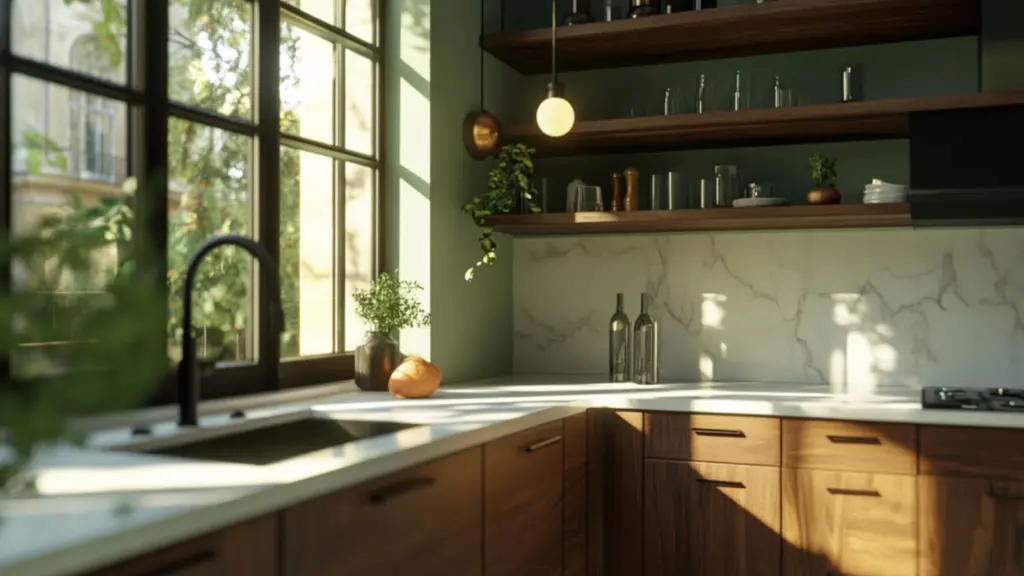
Green and wood alone may feel too earthy if not balanced correctly. Introducing metal and stone brings a touch of structure and contrast to the design. Brass and matte black are popular finishes for hardware, lighting, and faucets. Stone elements like soapstone countertops or marble slabs bring elegance and durability.
This interplay of textures keeps the space from feeling flat. For example, matte black hardware on deep green cabinets adds definition, while brass pulls on sage cabinetry offer warmth and subtle glamour. Use stone or quartz to add a smooth surface that balances the texture of wood and the depth of green.
Balanced Material Combos
| Metal or Stone | Best Placement | Style Benefit |
|---|---|---|
| Brushed brass | Drawer pulls, faucets | Adds luxe warmth |
| Matte black | Lighting, fixtures | Modern edge, bold contrast |
| Soapstone | Countertops | Durable, natural texture |
| White quartz | Island tops, backsplashes | Clean, brightens darker greens |
Styling Decor Elements the Natural Way
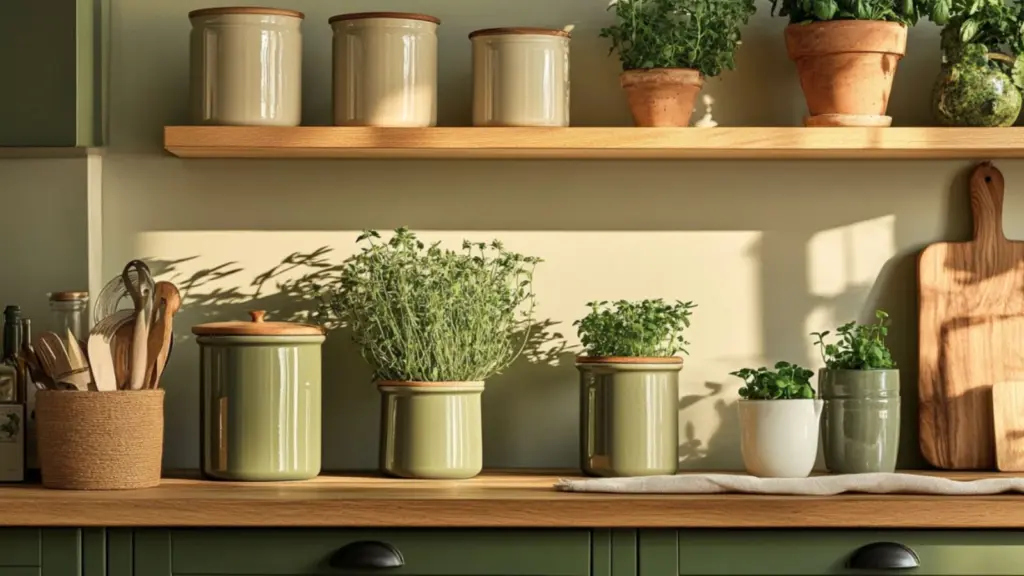
Decor is the finishing touch that ties your green and wood kitchen together. Opt for a mix of practical and beautiful items—think ceramic canisters, linen runners, wooden trays, and greenery. The key is to keep things natural and unfussy. Let your decor support the space’s laid-back, lived-in elegance.
Potted herbs like basil, thyme, or rosemary not only add a splash of green but also bring scent and utility. Use glass jars for dry goods, displayed neatly on wooden shelves. A simple clay pitcher, driftwood serving boards, or woven baskets can lend warmth without overpowering the room.
Avoid overly ornate or synthetic accessories. Keep the palette consistent with your green and wood tones. Earthy neutrals, soft whites, and muted blues make great accent colors.
Styling Tips for Green + Wood Kitchens
| Decor Element | Placement | Function + Style Tip |
|---|---|---|
| Potted herbs | Windowsills, shelves | Adds freshness and function |
| Woven baskets | Under island, on shelves | Storage with natural texture |
| Ceramic canisters | Countertops, open shelves | Neutral tones for dry goods |
| Wooden boards | Wall-mounted or stacked | Rustic utility and organic display |
Consider Layouts That Prioritize Light and Flow
A well-lit green kitchen comes alive. Natural light enhances the depth of green and the grain of wood, while open layouts help create a sense of connection and airiness. Whether you have a galley kitchen, an L-shape, or a wide open-plan space, keep traffic flow and visual openness in mind.
Opt for glass-front cabinetry or open shelving in upper zones to keep the kitchen from feeling top-heavy. Use a wooden island as a centerpiece for prep, dining, or display. Light fixtures should combine function with aesthetics—pendant lights with wooden detailing or industrial brass sconces complement this theme beautifully.
Layout Tips for Natural Harmony
| Layout Idea | Purpose | Style Enhancement |
|---|---|---|
| Open shelving | Reduces visual bulk | Highlights wood and decor |
| Center wood island | Prep + gathering space | Warms and anchors the space |
| Floor-to-ceiling windows | Maximize natural light | Highlights green tones beautifully |
| Multi-use zones | Dining, prep, display | Keeps design fluid and lived-in |
Conclusion
Green kitchen designs with wooden accents offer more than just visual beauty—they reflect a deeper desire to bring nature, calm, and timeless style into our homes. The combination of these two organic elements creates a space that is both functional and soul-nourishing.
Whether you choose a bold emerald cabinet or a subtle sage wall, pair it with thoughtfully selected wooden details to strike that perfect balance between elegance and earthiness. From countertops to decor, every element plays a role in shaping a kitchen that feels modern, cozy, and effortlessly connected to the natural world.

